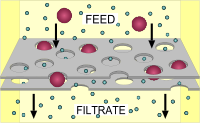
Photo from wikipedia
Abstract The paper is addressed to the application of Eulerian–Lagrangian Large Eddy Simulations (LES) for the investigation of the interaction between turbulent flow structures, heat transfer and particulate fouling in… Click to show full abstract
Abstract The paper is addressed to the application of Eulerian–Lagrangian Large Eddy Simulations (LES) for the investigation of the interaction between turbulent flow structures, heat transfer and particulate fouling in aqueous suspension on structured surfaces, which is an important research field in context of particle-laden two-phase flows. An efficient Lagrangian-Particle-Tracking algorithm is used to predict the trajectory of each suspended foulant particle (dispersed phase), suitable for dilute and dense dispersed two-phase flows by taking the fluid-particle (two-way coupling) as well as inter-particle interactions (four-way coupling) into account. The complex turbulent carrier flow (continuous phase) is calculated by eddy-resolving LES. Calculations have been performed for fully developed turbulent channel flows at moderate Reynolds numbers in combination with a sharp-edged spherical dimple considering a dimple depth/diameter ratio of t / D = 0.26 and a rectangular cavity with an equal cavity depth/side length ratio for comparative purposes. In order to get a detailed insight into fundamental fouling processes and to verify the numerical results high-precision experimental investigations of particulate fouling of different dimpled surfaces have been carried out. The fouling investigations are conducted using a relatively low mass loading of up to 0.2% and particle diameters of 3 µm and 20 µm for the simulations, whereas a particle diameter of 3 µm is used for the experiments. The simulated fouling layer distribution for the spherical dimple within a smooth, narrow channel is compared with these experimental measurements and exhibits a satisfying agreement. Additionally, the arising local flow structures and thermo-hydraulic performances of the selected surfaces are numerically investigated in absence and presence of particulate fouling.
Journal Title: International Journal of Heat and Fluid Flow
Year Published: 2018
Link to full text (if available)
Share on Social Media: Sign Up to like & get
recommendations!